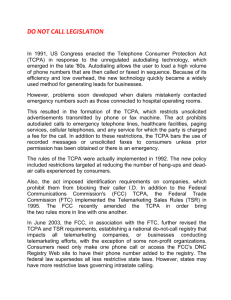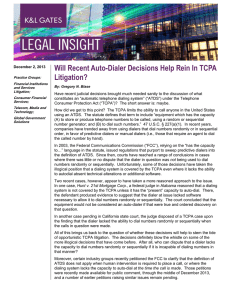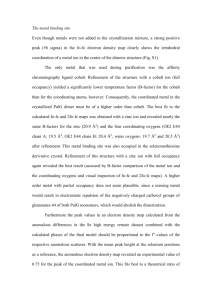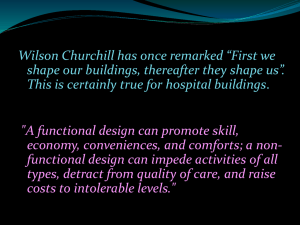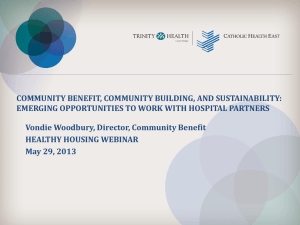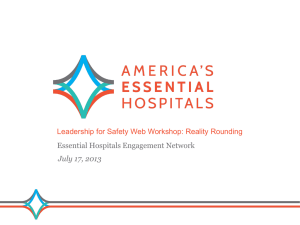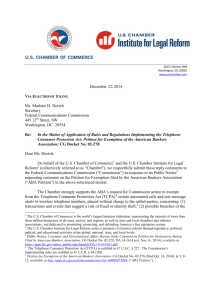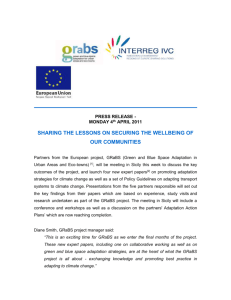AAHAM Legislative Day 2014 - Scott Noel
advertisement
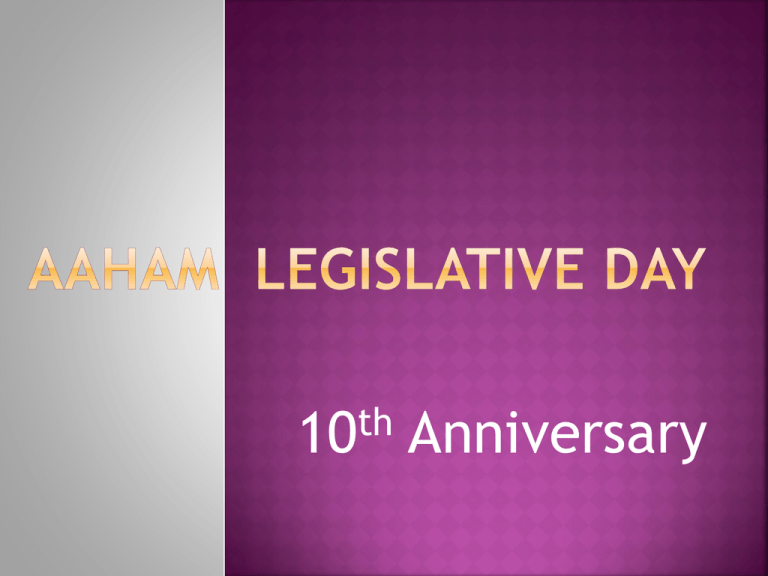
th 10 Anniversary Was held on April 23 & 24, 2014 Received tips on Grassroots Lobbying protocols and review of AAHAM Position. Appointments pre-set for each attendee based upon residence. Half-day visit schedule with debriefing at the end with the AAHAM group. Telephone Consumer Protection Act HISTORY: The Telephone Consumer Protection Act (TCPA) was passed by Congress in 1991 and signed into law by President George H. W. Bush as Public Law 102-243. It amended the Communications Act of 1934. The TCPA is codified as 47 U.S.C. 227. The TCPA restricts telephone solicitations (i.e., telemarketing) and the use of automated telephone equipment. The TCPA limits the use of automated dialing systems, artificial or prerecorded voice messages, SMS text messages, and fax machines. It also specifies several technical requirements for fax machines, autodialers, and voice messaging systems, principally with provisions requiring identification and contact information of the entity using the device to be contained in the message. OVERVIEW: Preliminary results from the January– June 2013 National Health Interview Survey (NHIS) indicate that the number of American homes with only wireless telephones continues to grow. Two in every five American homes (39.4%) had only wireless telephones (also known as cellular telephones, cell phones, or mobile phones) during the first half of 2013, an increase of 1.2 percentage points since the second half of 2012. In addition, nearly one of every six American homes (15.7%) received all or almost all calls on wireless telephones despite also having a landline telephone. This report presents the most upto-date estimates available from the federal government concerning the size and characteristics of these populations. At the time the TCPA legislation was passed, over 90% of U.S. households relied on their home or land-line phone. Only 3% of Americans had a mobile phone – they were truly the province of the elite. Today, the trend is away from landline phones, nearly 2 in 5 American homes no longer have them, and toward mobile-only households. And a new form of communication, text messaging has emerged. In 2012, more than 2.19 trillion text messages were sent and received. In 1991, legislators had no way of predicting the growth of the mobile market or the rapid adoption of text messaging as a critical form of communication. The TCPA was designed to protect consumers from receiving unsolicited telemarketing calls in their homes at all hours of the day and night. To prevent these intrusive calls, Congress restricted the use of “automatic telephone dialing systems”, broadly limited the use of pre-recorded voice messages and prohibited outreach to mobile phones without “prior express consent” from the call recipient. Twenty three years since its passage, the TCPA has become outdated. It restricts Americans from receiving customer service messages they want, including healthcare appointment reminders, credit card fraud alerts, notifications of travel changes, power outage restoration, UPS delivery information and more. Further, it prevents them from receiving these communications on the device they prefer, their mobile phones. The Affordable Care Act (ACA) requires hospitals and outpatient clinics to perform post-discharge follow-up with patients to reduce the rate of readmission, a big contributor to the cost of healthcare. We know the reminders, surveys, and education that have proven to lower readmission rates, can be successfully and cost effectively conducted by phone. However, under the TCPA, these calls are high-risk if the patient’s primary contact number is a mobile number and the patient didn’t expressly provide the mobile phone number for that purpose. RECOMMENDATION: Congress should immediately move to modernize the TCPA to allow automated dialing technology to be used to text or call mobile phones, as long as these texts or calls are not for telemarketing purposes. These changes are critical to the future of technology and how people communicate and send and receive information. Recommended language: The TCPA shall be changed to allow for non- telemarketing calls and text messages to mobile phones as long as consumer has given permission in writing on any form. Use of autodialer technology would be allowed, for non -telemarketing calls and as long as the numbers dialed are not randomly generated and there is a business to consumer relationship, which include third party relationships. Section 501(r), added to the Code by the Patient Protection & Affordable Care Act (PPACA), imposes new requirements on 501(c)(3) organizations that operate one or more hospital facilities (hospital organizations). Each 501(c)(3) hospital organization is required to meet four general requirements on a facility-by-facility basis: establish written financial assistance and emergency medical care policies; limit amounts charged for emergency or other medically necessary care to individuals eligible for assistance under the hospital's financial assistance policy; make reasonable efforts to determine whether an individual is eligible for assistance under the hospital’s financial assistance policy before engaging in extraordinary collection actions against the individual; and Conduct a Community Health Needs Assessment (CHNA) and adopt an implementation strategy at least once every three years. (These CHNA requirements are effective for tax years beginning after March 23, 2012). OVERVIEW: As hospitals await the release of final charity care rules, the Internal Revenue Service and Treasury issued two notices in 2014, instructing them to follow proposed rules that implement Affordable Care Act requirements. "We want to remind charitable hospitals that they must also take important steps to protect patients – including protecting them from hidden and high prices, and unreasonable collection actions," the Treasury stated in a blog post about the guidance. The first notice includes a procedure for hospitals to correct and disclose failures to satisfy the requirements under section 501(r) of the Internal Revenue Code. Following this process would assure hospitals that they would not lose their tax-exempt status, according to the Treasury. The second notice specifies charitable hospitals’ responsibilities under section 501(r). Specifically, the proposed rules require tax-exempt hospitals to "clearly define the financial assistance available, how to apply for it and publicize their policies so that community members are aware that aid is available." The regulations also include provisions to "curb the use of discriminatory pricing and collection schemes—by providing that individuals eligible for financial assistance cannot be charged more for medically necessary care than insured individuals, explicitly prohibiting collections activities in emergency rooms and requiring tax-exempt hospitals to re-issue previous bills at a discounted amount if a patient is later determined to be eligible for financial assistance." Issue: If hospitals have effectively communicated their Financial Assistance Policy (FAP), the proposed 120-day notification period allows sufficient time for completion of a FAP application. Adding a second 120-day period that precludes collection actions requiring a legal or judicial process will inhibit collections from patients with resources available to pay rightly owed balances. Proposed Solution: The Fair Debt Collection Practices Act’s 30-day notice for validation of debt should be applied after the provider turns an account over to a third-party collection agency. Additional notification periods are unnecessary. Issue: Emergency Medical Care Policy (EMCP) requirements both duplicate and conflict with federal Emergency Medical Treatment and Labor Act Requirements (EMTALA). Propose Solution: EMTALA should continue to be the controlling federal guidance for a hospital’s interactions with patients in the emergency department. Issue: Requirements to demonstrate “reasonable efforts” are unnecessarily burdensome and will increase costs without increasing access to care or benefiting the patient. Proposed Solution: If hospitals document the steps taken to verify eligibility but have not had the cooperation of the patient, or are unable to establish presumptive charity from other records that should satisfy the requirement of “seeking to determine whether an individual is financial assistance policy (FAP)-eligible”. Issue: The regulations appear to require that financial assistance for the insured may be provided only if the Amounts Generally Billed (AGB) is applied, which could limit access to assistance for the underinsured. The intent for the limitation on charges was to provide the uninsured the benefit of rates paid by the insured. Requiring that assistance for the insured is provided at the same level as the uninsured would create confusion and misapplication of the standard. Proposed Solution: The final regulations should confirm that hospitals may continue to offer assistance to the insured, at their discretion, though their financial assistance policies and clarify that the AGB does not apply to assistance for the insured. RECOMMENDATION: AAHAM urges Congress to request the U.S. Department of Treasury hold off issuing any final rule until issues above and others identified by industry are addressed. We would urge Congress to put off any final rule until there is a better understanding how any final rule will impact requirements included in the Affordable Care Act. Scott A. Noel, CRCS-I, BSHP, MPA Regional Account Executive, MDS First VP, Texas AAHAM Bluebonnet Chapter
